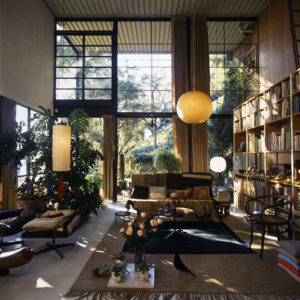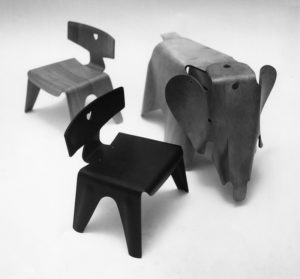A Rare Glimpse into Two Masters’ Lives: Exploring the Charles and Ray Eames House
EMERGING SCHOLARS > SUMMER RESEARCH GRANTS
by Rachel Pool
Tucked behind sprawling eucalyptus trees in the Pacific Palisades, the Charles and Ray Eames House is a showcase of the most notable collaborative couple in 20th century American design. The Decorative Arts Trust’s DARTS Summer Research Grant allowed me to travel to California to study the Eameses’ mid-century designs, home, and the Scandinavian influences seen in their work.
During a course at Parsons about Charles and Ray Eames (1907–1978 and 1912–1988, respectively), I became fascinated with the foreign influences present in their design oeuvre, including at their house, Case Study House #8 in Pacific Palisades, CA (figure 1). Completed in 1949 as part of the Case Study House Program, the dwelling is an example of modern American architecture in its most functional form. After marrying in 1941, Charles and Ray (figure 2) moved to California and began to design their home.
I was greeted by Lucia Atwood, Charles Eames’s granddaughter, outside of Case Study House #8. After discussing the exterior and the possible foreign influences evident in the architecture, I asked Lucia about the commonly conceived notion that the building’s grid design in primary colors resembles paintings by Dutch De Stijl artist Piet Mondrian. She replied that Ray was not fond of the comparison with Mondrian and that Ray performed thoughtful and meticulous color studies for the home’s exterior color palette. She added that, after in-depth exploration, Ray felt there was really only one result when working with a grid and that designers can arrive at a similar design using different methodologies.
Noticeable in their home, meticulously preserved today by the Eames Foundation, is a unique collection of objects from Charles and Ray’s travels, ranging from children’s books to gifts from their notable friends in the art and design world. Prior to my visit, I watched Charles and Ray’s 1955 film, House: After Five Years of Living, in order to gain an understanding of how the objects were arranged while they were living in Case Study House #8.
The kitchen was a highlight of the interior tour. Rarely photographed, the display of dishes and Ray’s thoughtful groupings of ceramics, shells, and taper candles melted organically onto candlesticks were a delight to see.
Ray’s collection of ceramics on her stove included a bright, cobalt blue and white sugar jar. I recognized the pattern as one of the timeless designs of the Rörstrand porcelain manufacturers of Sweden. Lucia picked up the sugar pot and on the bottom was the Rörstrand mark, affirming my conclusion. Charles and Ray’s sugar pot is of the Mon Amie pattern, designed by Marianne Westman. The Swedish sugar pot, possibly purchased by the Eameses or presented as a gift, perfectly emulated the couple’s appreciation for well-designed objects.
In the living room, Lucia discussed the conservation work completed by the Foundation, such as replacing the vinyl floor tiles and repairing doors and windows, with a goal of extending the life of the home’s contents (figure 3). As we were standing in the cozy seating area surrounded by books and artwork, I asked if Charles and Ray visited Scandinavia. Lucia confirmed that they traveled there many times and their designs were indeed inspired by the culture.
In Charles and Ray’s studio, the use of the heart and elephant as motifs in the Eameses’ work ties them to Scandinavia where a heart cut-out is often used in architecture on windows and doors. Although the heart and elephant are global emblems, the simplified forms and use of them in the home connect Charles and Ray to Scandinavia. Most noticeably, Charles and Ray’s Children’s Chairs have a heart cut out on their back for children to use as a hand hold, and as an element to humanize living spaces (figure 4). Additionally, the simultaneous use of the elephant as a motif is thought provoking—seen as a trademark symbol for Danish design company Georg Jensen, Swedish design shop Svenskt Tenn, and for the Eames Elephant children’s chair—all utilized as a form for items in the home.
Charles and Ray’s goal was to use a minimal amount of materials to create a rational home that was above all else, connected to nature. The use of floor-to-ceiling glass, indoor plants, and Ray’s carefully-curated collections of shells, rocks, and other natural specimens linked their home visually and physically to their surrounding environment, overlooking the Pacific Ocean.
The visit to the Eames House would not have been possible without the DARTS Summer Research Grant and provided me with valuable information about their life and work. Exploring the space and analyzing the collection closely was an integral component of my research, particularly in light of the dearth of photographs depicting the home’s interior and its objects. Lucia’s love and appreciation for her family history is evident by her decision to leave the house exactly the way it was when Ray passed away, a nod to Ray’s strong sense for curation, design, and the deep connection she had with her worldly collections.
Rachel Pool is a MA Candidate, Parsons School of Design; a Fellow, Cooper Hewitt, Smithsonian Design Museum; and a 2019 DARTS Summer Research Grant Recipient.
A print version of this article was published in The Magazine of the Decorative Arts Trust, one of our most popular member benefits. Join today!




